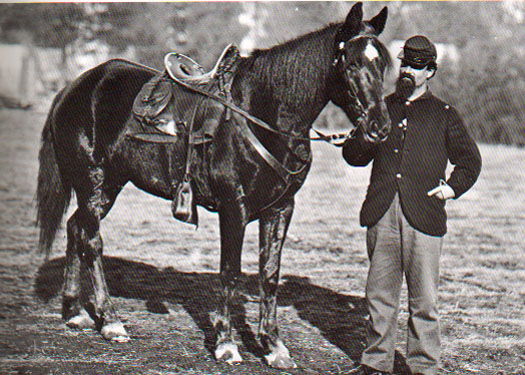|
Horsemen
Here are period pictures, thumbnails, drawings, lithographs, etc... of soldiers who served on horseback.
|
|

An unknown Federal office with his well turned out mount. The horse has more regulation "dress" than the officer. Note the McClellen saddle, breast plate, and saddle bags. The office is wearing a simple sack coat with epallettes and plain sky blue troussers.
|
A mounted Light Artillery Battery deployed for action.
Artillerymen needed to be horsemen too. Battery horses were among the highest number of animal casualties in the war. |
|
|
|
The 1st US Cavalry.
This picture was taken on the Brandy Station battlefield in Virginia a short time after the battle. |
Cavalry Blacksmiths and their Traveling Forges
Blacksmiths in the Federal army were grouped together in special units. Most Federal cavalry regiments had a man or two who could fit a horse shoe in an emergency, but the real job of shoeing was done in camp or in remount depots. The southern cavalry units included men who were "farriers" (horse shoers). These men were paid and respected as corporals. The southern cavalry generally lacked the organization in depth for support of their mounted arm. This hurt their operations in the long run. |
|
|
|
Cavalry Fording a River
This is a period watercolor of Federal cavalry crossing Kelley's Ford in Virginia. The nature of the geography of Northern Virginia, a tangle of rivers, streams, and creeks which generally flowed from west to east, forced the cavalry to make crossings like this many times. Each ford was jeolously defended to prevent the movement of the enemy. |
This is just a great picture!
It seems to capture the essence of the horse artillery in combat. |
|
|
|
Sheridan's charge against the Confederate lines at Five Oaks.
|
Sheridan's Ride at the Battle of Cedar Creek. Both the general and his horse, Rienzi, gained great acclaim in the northern press.
|
|
|
|
The Cavalry Charge at Upperville
|
General Nathan Bedford Forrest with one of the twenty-nine horses shot out from under him in battle.
|
|
|
|
The Federal Cavalry resting at Kelley's Ford, Virginia. This period sketch is dated 1863.
|
This is a drawing by Leslie's artist Alfred Waud of the 1st Virginia Cavalry.
Waud noted that the Virginians held the Federal Cavalry in great contempt. The Virginians were almost all armed with captured Federal equipment especially the carbines. |
|
|
|
|
|
|